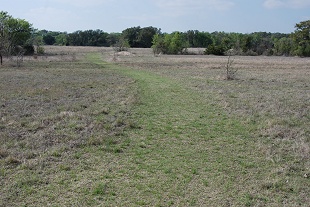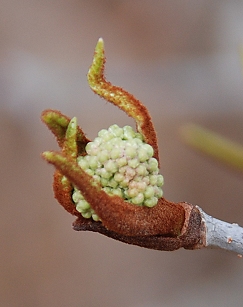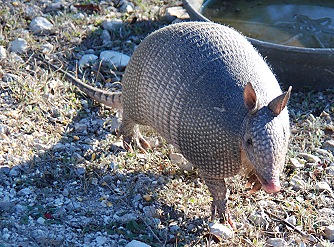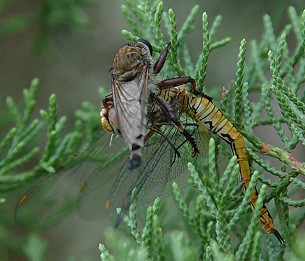Jun 04
Posted: under Activities, Plantlife.
Tags: Activities, beauty, land management, native plants, prairie restoration June 4th, 2009
If land managers had ten thousand years to play with the land, prairie restoration would be a lot easier, even if they had to start with an overgrazed, eroded, compacted, heavily-invaded, polluted mess. But we don’t. So some basic principles have been laid down–initially during research on northern prairies–that now govern most prairie restoration projects: […] [...more]
If land managers had ten thousand years to play with the land, prairie restoration would be a lot easier, even if they had to start with an overgrazed, eroded, compacted, heavily-invaded, polluted mess. But we don’t. So some basic principles have been laid down–initially during research on northern prairies–that now govern most prairie restoration projects: physical removal of invasive woody plants by fire (cheap) or various mechanical clearing methods (more expensive) , grazing management to interrupt succession, physical disturbance of the soil (discing, for instance) to induce germination of dormant seeds.
Read the rest of this entry »

Mar 16
Posted: under Activities, Plantlife, Water, Weather.
Tags: beauty, observation, photography, water resource management, Weather March 16th, 2009
Plants around here take immediate advantage of water, so the change in color after less than a week from the first drop of rain is striking. Not only does green show on the mowed maintenance path, but at the base of the taller clumps to either side. Rain started Wednesday; this was taken Sunday. Last […] [...more]
Plants around here take immediate advantage of water, so the change in color after less than a week from the first drop of rain is striking.

Near Meadow
Not only does green show on the mowed maintenance path, but at the base of the taller clumps to either side. Rain started Wednesday; this was taken Sunday. Last week, no green.
Read the rest of this entry »

Feb 13
Posted: under Activities, Wildlife.
Tags: Activities, bird behavior, census February 13th, 2009
The annual GBBC sponsored by Cornell University and the Audubon Society is our big bird census activity of the year. Usually I spent 1-2 hours in each of four sites on the land, but this year (since I’m under orders not to overdo as I recover from pneumonia) today’s observations at least will all be […] [...more]
The annual GBBC sponsored by Cornell University and the Audubon Society is our big bird census activity of the year. Usually I spent 1-2 hours in each of four sites on the land, but this year (since I’m under orders not to overdo as I recover from pneumonia) today’s observations at least will all be literally “yard” ones. So far that’s only eleven species….but my “special bird” in the year, the female Pyrrhuloxia, is still here. (Usually I see a really interesting bird the day before the count starts, and then not again until afterwards.)
Anyone who’s never participated should consider doing so…it’s fun and it contributes useful information on bird distribution in winter. There are maps, updated constantly, showing where observations have come from.

Feb 13
Posted: under Activities, photography, Plantlife.
Tags: Activities, drought, photography February 13th, 2009
Even in a dry year, spring comes early to central Texas. I’m recovering from pneumonia so can’t get out to the full 80 acres, but here are some pictures from around the house. (I need to plant some elbowbush up by the house, as it’s one of the very earliest.) Rusty blackhaw viburnum is one […] [...more]
Even in a dry year, spring comes early to central Texas. I’m recovering from pneumonia so can’t get out to the full 80 acres, but here are some pictures from around the house. (I need to plant some elbowbush up by the house, as it’s one of the very earliest.)

Rusty Blackhaw Viburnum bud
Rusty blackhaw viburnum is one of the most beautiful of the native shrubs, but it’s routinely scraped off by developers as “brush”. Here, the buds are just opening to show the bud-cluster that will be a puffball of pure white within a week. Easy to see why it acquired the name “rusty.” It’s a valuable plant for wildlife, producing tasty blue berries for birds–and nectar for the early butterflies and moths.
Read the rest of this entry »

Jan 18
Posted: under Activities, photography, Plantlife, Wildlife.
Tags: Activities, photography, wildlife management January 18th, 2009
Yesterday was the “nose to the grindstone” day for putting the annual report in final form, including choosing which pictures to include to show the story of the year on our place. The official form has nine pages. Add to that a cover sheet with our names and other useful information the form itself doesn’t […] [...more]
Yesterday was the “nose to the grindstone” day for putting the annual report in final form, including choosing which pictures to include to show the story of the year on our place.
The official form has nine pages. Add to that a cover sheet with our names and other useful information the form itself doesn’t have space for, and three pages of supplementary notes referencing specific points of the form (which, for instance, does not have a check-box for “check-dams/gabions” under “erosion control”–just ponds, dykes, and levees, so I have to add a note about our check-dams and gabions every year) , and then 14 pages that I call the Activity Report, detailing (well, outlining, but in more detail than their Annual Report Form makes possible) the activities we’ve done in each of the seven management areas with (where possible) photographs.
(Photos beyond the break)
Read the rest of this entry »

Jan 12
Posted: under Activities, Plantlife, Wildlife.
Tags: Activities, Animal behavior, beauty, observation, photography, supplemental feeding, wildlife management January 12th, 2009
Today’s wildlife experience was an armadillo, drinking noisily (they slurp, sounding rather like dogs) from the overflow guzzler at Fox Pavilion when we came back around that way after a long, two-hour stroll around the place. I thought I’d turned the water off completely, but some grit must’ve been in the faucet, because the water […] [...more]
Today’s wildlife experience was an armadillo, drinking noisily (they slurp, sounding rather like dogs) from the overflow guzzler at Fox Pavilion when we came back around that way after a long, two-hour stroll around the place. I thought I’d turned the water off completely, but some grit must’ve been in the faucet, because the water had overflowed.

Read the rest of this entry »

Jan 09
Posted: under Activities, Wildlife.
Tags: bird behavior, photography, supplemental feeding, wildlife management January 9th, 2009
We have four or five different bird populations on the place, and the first year I thought the winter-resident bunch were the dullest. After all, it’s not their breeding season, so those that have a bright breeding plumage don’t have it here. Then there are the sparrows–for two years they defeated my attempts at bird […] [...more]
We have four or five different bird populations on the place, and the first year I thought the winter-resident bunch were the dullest. After all, it’s not their breeding season, so those that have a bright breeding plumage don’t have it here. Then there are the sparrows–for two years they defeated my attempts at bird identification because I didn’t spend enough time learning which small streaky brown bird was which.
Then I spent a winter sitting out in the dry woods with binoculars day after day and discovered the beauty of winter sparrows. Now the winter birds are one of my favorite subgroups. They can’t compete with the painted buntings we get in late spring (nothing can!) but I enjoy them. And the American goldfinches, arriving all brown, with the black-and-white echelons of their wingtips on the back, gradually transform toward spring into the familiar yellow and black northerners see.
Read the rest of this entry »

Jan 01
Posted: under Activities, Equipment, Land.
Tags: Activities, land management January 1st, 2009
The remnant pocket prairie in the creek woods that we call the “entrance meadow (it’s almost enclosed by woods and is the formal entrance to the thickest part of them) was for the first six years the best seed bank we had of original native plants. Little bluestem, Indiangrass, sideoats grama, Maximilian sunflower, pitcher sage, […] [...more]
The remnant pocket prairie in the creek woods that we call the “entrance meadow (it’s almost enclosed by woods and is the formal entrance to the thickest part of them) was for the first six years the best seed bank we had of original native plants. Little bluestem, Indiangrass, sideoats grama, Maximilian sunflower, pitcher sage, Illinois basketflower, brown-eyed Susan, gayfeather, and others are all found in this small area. Now that we have established other seed-source areas, we’re not as dependent on it, but we still want to maintain it as a pocket prairie, not let it be overgrown with greenbriar, cedar elm, roughleaf dogwood.
So, every winter, I mow it, on the highest setting the small mower can give (the large mower won’t even get into it.) Today was a good day for that, so today I got it done. I don’t try to break down all the tall stalks of the forbs (that takes repeated passes) but do try to knock them about and cut the grass at about 4.5 inches. “About” because it’s not absolutely level. In the scheme of things, this counts as “habitat management.”
On the way back, I mowed one of the work trails (useful for censusing grassland birds, among other things.)
Other work today (some done by R-) included checking all the wildlife waterers and putting out feed for migrant birds. That, of course, falls under “supplemental water” and “supplemental feeding.”

Dec 20
Posted: under Activities, photography, Wildlife.
Tags: Activities, Animal behavior, census, observation, photography December 20th, 2008
I’ve started working on a long-term project to define who eats what and is eaten by whom. Published sources are not as much help as you might think, since they’re not really local and the local mix of food sources varies from both historical record (we have different plants, in different proportions, and thus different […] [...more]

Robberfly taking a large dragonfly
I’ve started working on a long-term project to define who eats what and is eaten by whom. Published sources are not as much help as you might think, since they’re not really local and the local mix of food sources varies from both historical record (we have different plants, in different proportions, and thus different proportions of animals for the meat-eaters to prey on) and from published sources set in a different area.
It’s being every bit as difficult I suspected it would be. Critters do not all come and pose in front of the camera with an array of their food sources so consumption can be documented. Nor are they limited to the foods we put out. Killing a lot of native critters to do stomach content analyses (a very accurate way of finding out what *that* individual ate, but non-reproducible in that individual) isn’t something I want to do, or have the time and expertise to do anyway. Read the rest of this entry »

Nov 29
Posted: under Activities, Wildlife.
Tags: beauty, photography, wildlife management November 29th, 2008
Here beginneth the 80 AcresOnline blog…where I’ll be talking about our wildlife management project and other nature-related topics from time to time. Construction’s still going on at the website, so expect only short bits here for awhile. Today’s walk? Color, color, color: flameleaf sumac (aptly named), yellow elbowbush and Mexican buckeye, rich red rusty blackhaw […] [...more]
Here beginneth the 80 AcresOnline blog…where I’ll be talking about our wildlife management project and other nature-related topics from time to time. Construction’s still going on at the website, so expect only short bits here for awhile.
Today’s walk? Color, color, color: flameleaf sumac (aptly named), yellow elbowbush and Mexican buckeye, rich red rusty blackhaw viburnum, pink-through-rose-to-purple roughleaf dogwood. Yellow and orange butterflies, including one lone monarch vainly trying to fly into a stiff north wind.





